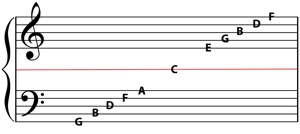There are 21 different possible notes: Ab, A, A#, Bb, B, B#, Cb, C, C#, Db, D, D#, Eb, E, E#, Fb, F, F#, Gb, G, and G#. In western music there are overlaps (e.g. Ab and G# are the same thing) so there are actually only 12 notes:A, A#/Bb, B/Cb, B#/C, C#/Db, D, D#/Eb, E/Fb, F/E#, F#/Gb, G, G#/Ab - but in eastern music (like Gamelan or Indian Classical music) there are many other possibilities.

Of course, there are much more than 12 pitches; each note can be played in any octave e.g. a G can be played, as an example, below middle C and above middle C.
Intervals:
Intervals are just the gaps between notes, and how big these gaps are.
2nd - Minor - 1 semitone
- Major - 2 semitones
- Augmented - 3 semitones
3rd - Minor - 3 semitones
- Major - 4 semitones
- Augmented - 5 semitones
4th - Diminished - 4 semitones
- Perfect - 5 semitones
- Augmented - 6 semitones
5th - Diminished - 6 semitones
- Perfect - 7 semitones
- Augmented - 8 semitones
6th - Minor - 8 semitones
- Major - 9 semitones
- Augmented - 10 semitones
7th - Minor - 10 semitones
- Major - 11 semitones
- Augmented - 12 semitones
Octave - Diminished - 11 semitones
- Perfect - 12 semitones
There are such things as compound intervals as well, but they are just made up of these intervals plus octaves.
The tritone (augmented 4th/diminished 5th) is the furthest interval, and sounds extremely dissonant. It is often used in jazz and heavy metal to create tension.
Rhythms:
There are 8 main note lengths, without getting into complete obscurity.
1. Breve (unusual): length = 8 beats

2. Semibreve: length = 4 beats

3. Minim: length = 2 beats

4. Crotchet: length = 1

5. Quaver: length = 1/2

6. Semiquaver: length = 1/4

7. Demisemiquaver:

8. Hemidemisemiquaver:

And it goes on.
However, there are also some other rhythmic features.
Triplets: when you play 3 notes in the space of two.

Dotted rhythm: when the note is held for an extra half it's length.

No comments:
Post a Comment